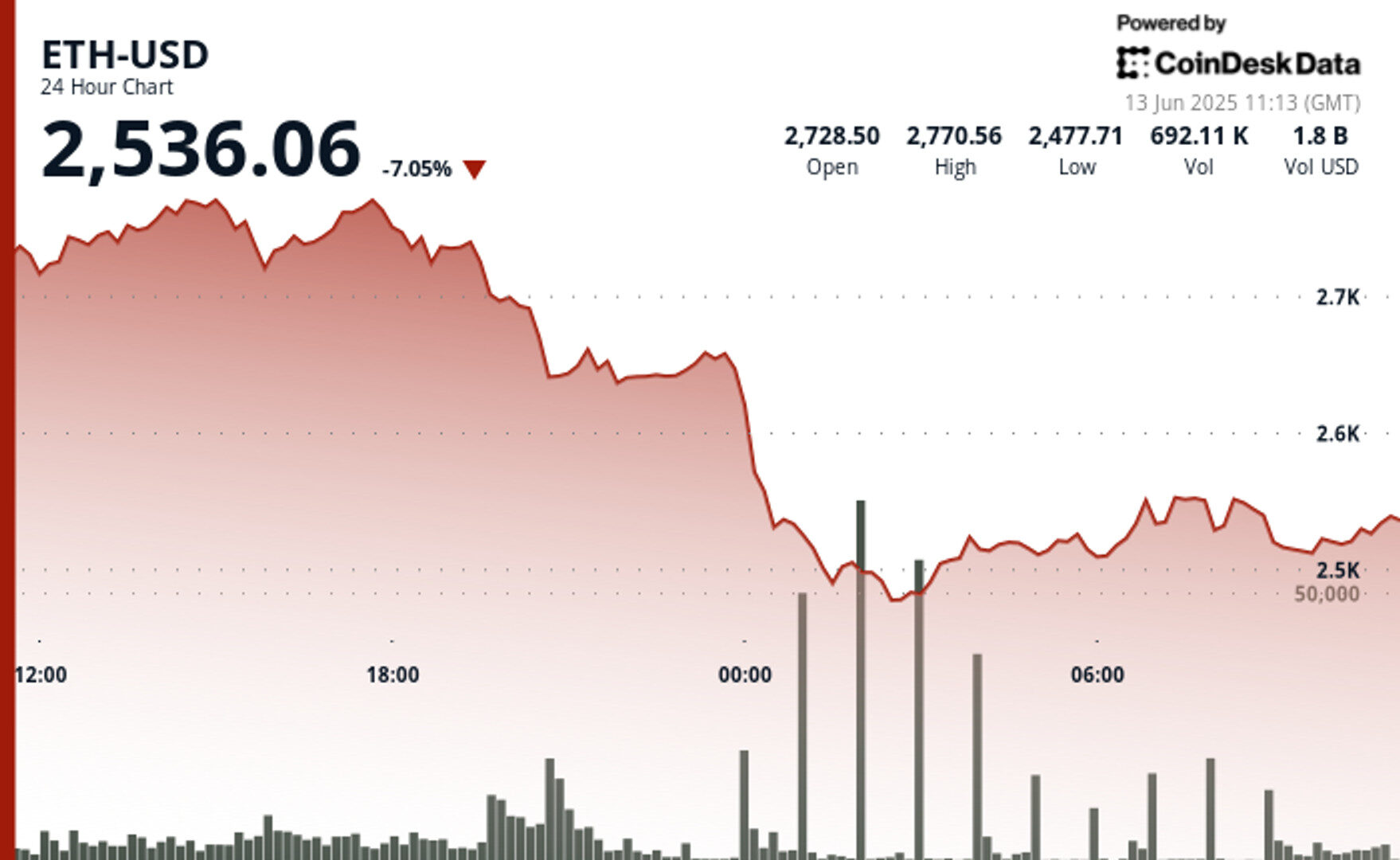BTC
$105,184.45
–
1.77%
ETH
$2,562.37
–
6.65%
USDT
$1.0003
+
0.03%
XRP
$2.1669
–
3.27%
BNB
$653.65
–
1.37%
SOL
$146.24
–
8.16%
USDC
$0.9997
+
0.00%
DOGE
$0.1762
–
6.54%
TRX
$0.2732
–
1.22%
ADA
$0.6431
–
6.03%
HYPE
$40.48
–
1.07%
SUI
$3.0374
–
7.63%
LINK
$13.41
–
5.82%
LEO
$9.0583
+
2.59%
BCH
$419.58
–
2.50%
AVAX
$19.30
–
8.18%
XLM
$0.2607
–
5.15%
WBT
$34.33
+
4.97%
TON
$2.9846
–
6.26%
SHIB
$0.0₄1186
–
6.45%
By Siamak Masnavi, CD Analytics|Edited by Aoyon Ashraf
Jun 13, 2025, 11:39 a.m.

- ETH dropped 7.05% to $2,536.06 with sharp losses concentrated during U.S. evening trading, according to CoinDesk Research’s technical analysis model.
- Volume reached nearly 692K ETH as price fell from a high of $2,770.56 to $2,477.71.
- The drop coincided with a global risk-off move following Israeli military strikes in Iran.
- A modest bounce from the $2,480 area has seen ETH stabilizing in the $2,530 range
Ether (ETH)
tumbled more than 7% over the past 24 hours, falling from a session high of $2,770.56 to as low as $2,477.71 before recovering slightly to $2,536 at press time.
The sharp decline came amid a broad risk-off move across global markets following Israeli airstrikes on Iranian military infrastructure — a major escalation in Middle East tensions that caught investors off guard.
Story continues
According to a report by CNBC, Israeli Prime Minister Benjamin Netanyahu said the strikes were part of a “targeted military operation” against Iran’s nuclear and missile programs. Iran responded by launching around 100 drones toward Israel in retaliation. While the United States denied direct involvement, Secretary of State Marco Rubio emphasized that America’s priority was protecting its regional forces.
In response to the rising geopolitical risk, investors fled into traditional safe-haven assets. The U.S. dollar rallied 0.6% on Friday morning, reversing a three-year low from the previous day. Gold also surged to near a two-month high, while oil futures spiked as much as 13% before paring gains. The dollar’s strength was particularly notable as it outperformed other safe-haven currencies like the Swiss franc and Japanese yen.
Market strategists noted that the conflict’s depth and duration—especially its impact on oil — would shape investor behavior going forward. ING analysts said the dollar’s rebound was significant, even if more muted than expected. Meanwhile, Bank of America’s survey showed that traders remained heavily short the dollar, though conviction in that trade had not yet collapsed.
ETH’s sharp move lower aligned with similar risk-asset weakness seen across equities, bonds, and commodities. While prices have steadied above the $2,530 level for now, volatility is likely to remain elevated as traders digest the unfolding geopolitical situation.
Technical Analysis Highlights
- ETH fell from $2,770.56 to a low of $2,477.71 — a 10.6% intraday drop.
- Volume surged to 692,000 ETH as selling intensified during U.S. evening hours.
- Price briefly rebounded off the $2,480 zone but faced resistance below $2,550T.
- he latest flash move formed a tight consolidation band between $2,530–$2,540.
- Gradually declining volume suggests short-term exhaustion but no confirmed reversal yet.
Disclaimer: Parts of this article were generated with the assistance from AI tools and reviewed by our editorial team to ensure accuracy and adherence to our standards. For more information, see CoinDesk’s full AI Policy.
Siamak Masnavi is a researcher specializing in blockchain technology, cryptocurrency regulations, and macroeconomic trends shaping the crypto market. He holds a PhD in computer science from the University of London and began his career in software development, including four years in the banking industry in the City of London and Zurich. In April 2018, Siamak transitioned to writing about cryptocurrency news, focusing on journalism until January 2025, when he shifted exclusively to research on the aforementioned topics.
CoinDesk Analytics is CoinDesk’s AI-powered tool that, with the help of human reporters, generates market data analysis, price movement reports, and financial content focused on cryptocurrency and blockchain markets.
All content produced by CoinDesk Analytics is undergoes human editing by CoinDesk’s editorial team before publication. The tool synthesizes market data and information from CoinDesk Data and other sources to create timely market reports, with all external sources clearly attributed within each article.
CoinDesk Analytics operates under CoinDesk’s AI content guidelines, which prioritize accuracy, transparency, and editorial oversight. Learn more about CoinDesk’s approach to AI-generated content in our AI policy.















